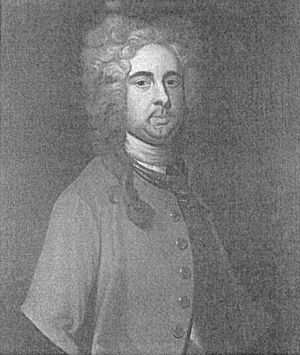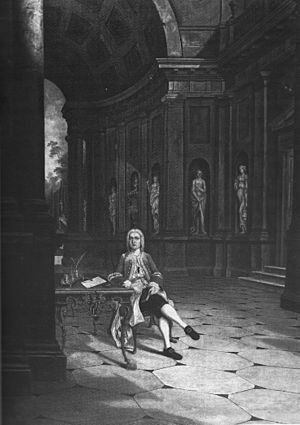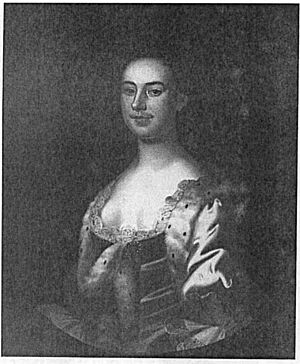Charles Calvert (governor) facts for kids
Quick facts for kids
Charles Calvert
|
|
|---|---|

Captain Charles Calvert, Governor of Maryland. Painting by John Wollaston. Collection of the Baltimore Museum of Art.
|
|
| 3rd Governor of Restored Proprietary Government | |
| In office 1720–1727 |
|
| Preceded by | Thomas Brooke |
| Succeeded by | Benedict Leonard Calvert |
| Surveyor General to the Western Shore | |
| In office 1726 – c. 1733 |
|
| Commissary General | |
| In office 1727–1728 |
|
| Personal details | |
| Born | 1688 England |
| Died | February 2, 1734 (aged 45–46) Maryland |
| Spouse | Rebecca Gerard |
| Children | 3, including Elizabeth Calvert |
| Occupation | Planter, politician |
Charles Calvert (1688 – February 2, 1734) was an important leader in the early history of Maryland. He served as the 14th Governor of Maryland starting in 1720. At this time, the Calvert family had just regained control of their colony.
Charles Calvert was chosen as governor by his cousin, Charles Calvert, 5th Baron Baltimore. His main jobs were to protect the Calvert family's interests and to make things smoother between the colony's leaders and its people. He also helped reduce religious disagreements, which had caused many problems before. In 1727, his cousin Benedict Leonard Calvert took over as governor. Charles Calvert continued to hold other important jobs in the colony until his death in 1734.
Contents
Early Life and Family Background
Charles Calvert was born in England in 1688. Not much is known for sure about his parents. He was born Charles Calvert Lazenby. It is believed he was connected to the powerful Calvert family, who owned the Maryland colony.
Military Career and Ranks
Before becoming governor, Charles Calvert was a soldier. He fought in England's wars against France and Spain. Around 1709, he likely reached the rank of ensign. Later, in 1718, he bought higher ranks in the army. He became a lieutenant and then a captain in the Grenadier Guards. These promotions were probably paid for by his wealthy Calvert family connections. Being in the Grenadier Guards was very respected, and commissions were expensive.
Serving as Governor of Maryland
Charles Calvert became Governor of Maryland around 1720. He was sent to Maryland to look after the interests of his Calvert relatives. The British Crown had taken control of Maryland after the Glorious Revolution in 1688. The Calvert family had only recently gotten it back.
He was chosen because he was loyal to the Crown and to his family. He also wanted to live in Maryland permanently. Calvert was a practical person. In his first speech to the Assembly, he kept it short. He told the delegates that his actions would show how he would help the colony.
Goals as Governor
One of his main goals was to calm tensions and bring peace to the colony. He worked hard to find a good balance between the needs of the Maryland colonists and the wishes of the Lord Proprietor. He also managed relationships with the local Algonquian tribes. To do this, he talked with leaders from the Seneca, Tuscarora, and Shawnee Native American groups.
Calvert replaced the previous governor, Thomas Brooke. He worked to strengthen the Calvert family's power. He also tried to ease disagreements between the government and the colonists. In a speech in 1725, he said he hoped that nothing would cause problems between the colonists and Lord Baltimore.
Marriage and Personal Life
As governor, Charles Calvert was a popular bachelor. He married Rebecca Gerard (1708-1734/35) on November 21, 1722. She was a wealthy heiress from Maryland and was only sixteen when they married. Their wedding brought a lot of celebrations to the colony. Rebecca was an only child, so her property, a plantation near Queen Anne's Town in Prince George's County, became Captain Calvert's.
Charles Calvert was also a very good horseman. He encouraged horse racing while he was governor. When he passed away, he owned a valuable thoroughbred horse.
Religious Harmony
During Calvert's time as governor, many of the religious arguments that had troubled Maryland politics before became much calmer. Rules that had limited the practice of Roman Catholicism were eased. Overall, there was much less religious conflict in the colony.
End of Governorship

Captain Calvert was replaced as governor in 1727. His cousin, Benedict Leonard Calvert, who was the brother of Charles Calvert, 5th Baron Baltimore, arrived in Maryland to take over. The change of power was not completely smooth. Captain Calvert wanted to keep half of a special tax on tobacco. Benedict was not happy about this. Family members in England were also surprised by Captain Calvert's actions. Lord Baltimore himself said that Benedict should receive the full tax.
After his time as governor, Charles Calvert continued to serve the colony. From 1726 to about 1733, he worked as the Surveyor General to the Western Shore.
His Children
Charles and Rebecca Calvert had three children:
- Charles (1723–1723/4), who died as a baby.
- Anne (1724–c.1737), who died as a child.
- Elizabeth Calvert (1731–1788), who married her cousin Benedict Swingate Calvert on April 21, 1748. Benedict Swingate Calvert was a wealthy planter. They had thirteen children together.
Later Years and Death
Captain Calvert began to experience health issues in his later years. He passed away on February 2, 1734, at the age of 42. He had arrived in Maryland without much money, but he died as one of the wealthiest people in the colony. His property was valued at a large sum of money. His wife, Rebecca, died soon after him. In 1737, their daughter Anne also passed away. This left their last child, Elizabeth, as an orphan, but she inherited a lot of wealth.
Legacy and Home
Captain Calvert's house at 58 State Circle in Annapolis was studied by archaeologists in the 1980s and early 1990s. The findings from this excavation, along with other research, were published in a book in 1994. The digging at the Calvert House was funded by several organizations.


